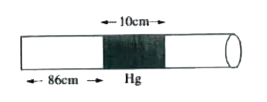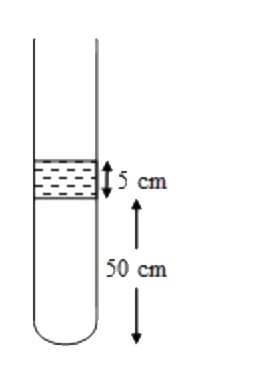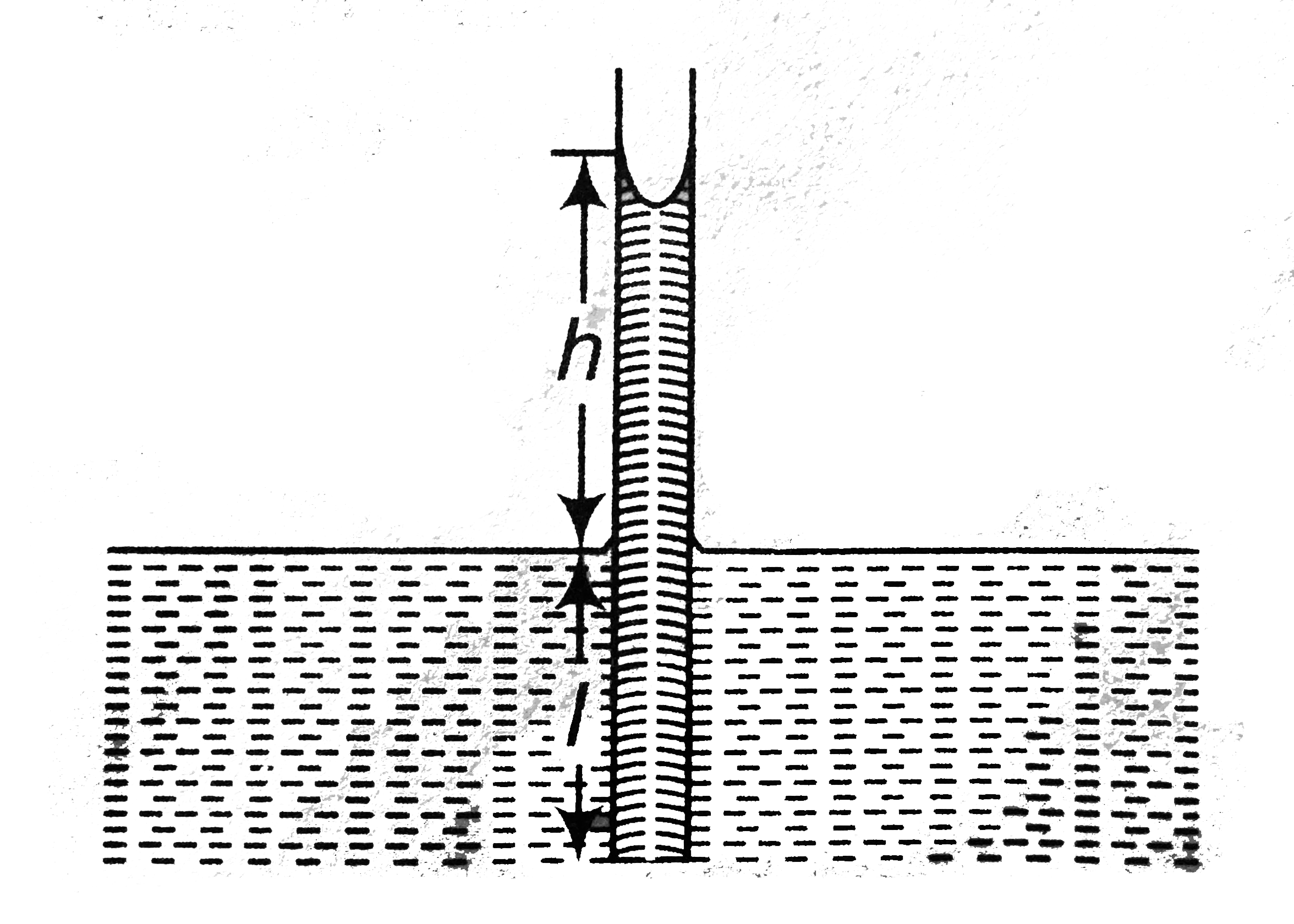An open glass tube is immersed in mercury in such a way that a length of 8 cm extends above the mercury level. The open end of the tube is then closed and sealed and the tube is raised vertically up by additional 46 cm. What will be length of the air column above mercury in the tube now? (atmospheric pressure =76 cm of Hg)
38 cm
6 cm
16 cm
22 cm
To solve the problem step by step, let's follow the reasoning outlined in the video transcript:
Step 1: Understand the Initial Setup
We have a glass tube that is open at one end and immersed in mercury. Initially, 8 cm of the tube extends above the mercury level.
Step 2: Determine Initial Conditions
When the tube is immersed in mercury, the height of the mercury column in the tube is balanced by the atmospheric pressure. The atmospheric pressure is given as 76 cm of Hg. Therefore, the pressure at the open end of the tube (which is in contact with the atmosphere) is equal to the atmospheric pressure.
Step 3: Close the Tube and Raise It
When the open end of the tube is sealed, and the tube is raised vertically by an additional 46 cm, the mercury level in the tube will drop due to the change in pressure conditions.
Step 4: Apply Pressure Relations
Let x be the length of the air column above the mercury after raising the tube. The pressure at the closed end of the tube (after raising) can be expressed as:
P2=P1−x
Where:
- P1=76 cm of Hg (atmospheric pressure)
- P2 is the pressure in the sealed tube.
Step 5: Set Up the Equation
Using the ideal gas law, we can relate the pressures and volumes before and after raising the tube:
P1V1=P2V2
Where:
- V1 is the initial volume of the air column (cross-sectional area A times the height of the air column, which is 8 cm).
- V2 is the new volume of the air column (cross-sectional area A times the new height, which is x).
Substituting the pressures:
76⋅(A⋅8)=(76−x)⋅(A⋅x)
Step 6: Simplify the Equation
Canceling the cross-sectional area A from both sides:
76⋅8=(76−x)⋅x
608=76x−x2
Rearranging gives us a quadratic equation:
x2−76x+608=0
Step 7: Solve the Quadratic Equation
Using the quadratic formula x=−b±√b2−4ac2a:
Here, a=1,b=−76,c=608:
x=76±√(−76)2−4⋅1⋅6082⋅1
x=76±√5776−24322
x=76±√33442
Calculating √3344≈57.8:
x=76±57.82
Calculating the two possible values:
1. x=133.82≈66.9 (not possible since it exceeds the total height)
2. x=18.22≈9.1
Step 8: Calculate the Length of the Air Column Above Mercury
The total height of the air column after raising the tube is:
Total height=54 cm−x
Substituting the value of x:
Length of air column=54−9.1≈44.9 cm
Final Answer
The length of the air column above mercury in the tube now is approximately 16 cm.
We have a glass tube that is open at one end and immersed in mercury. Initially, 8 cm of the tube extends above the mercury level.
When the tube is immersed in mercury, the height of the mercury column in the tube is balanced by the atmospheric pressure. The atmospheric pressure is given as 76 cm of Hg. Therefore, the pressure at the open end of the tube (which is in contact with the atmosphere) is equal to the atmospheric pressure.
When the open end of the tube is sealed, and the tube is raised vertically by an additional 46 cm, the mercury level in the tube will drop due to the change in pressure conditions.
Let x be the length of the air column above the mercury after raising the tube. The pressure at the closed end of the tube (after raising) can be expressed as:
P2=P1−x
Where:
- P1=76 cm of Hg (atmospheric pressure)
- P2 is the pressure in the sealed tube.
Using the ideal gas law, we can relate the pressures and volumes before and after raising the tube:
P1V1=P2V2
Where:
- V1 is the initial volume of the air column (cross-sectional area A times the height of the air column, which is 8 cm).
- V2 is the new volume of the air column (cross-sectional area A times the new height, which is x).
76⋅(A⋅8)=(76−x)⋅(A⋅x)
Canceling the cross-sectional area A from both sides:
76⋅8=(76−x)⋅x
608=76x−x2
Rearranging gives us a quadratic equation:
x2−76x+608=0
Using the quadratic formula x=−b±√b2−4ac2a:
Here, a=1,b=−76,c=608:
x=76±√(−76)2−4⋅1⋅6082⋅1
x=76±√5776−24322
x=76±√33442
Calculating √3344≈57.8:
x=76±57.82
1. x=133.82≈66.9 (not possible since it exceeds the total height)
2. x=18.22≈9.1
The total height of the air column after raising the tube is:
Total height=54 cm−x
Substituting the value of x:
Length of air column=54−9.1≈44.9 cm
The length of the air column above mercury in the tube now is approximately 16 cm.
Topper's Solved these Questions
Similar Questions
An open glass tube is immersed in mercury in such a way that a length of 8 cm extends above the mercury level. The open end of the tube is then closed and sealed and the tube is raised vertically up by additional 46 cm. What will be length of the air column above mercury in the tube now? (atmospheric pressure =76 cm of Hg)
View Solution
If above tube is placed vertically with the open and upward then find the length of the air column.View Solution
Knowledge Check
- Question 1 - Select One
A thin tube of uniform cross-section is sealed at both ends. It lies horizontally, the middle 5 cm containing mercury and the two equal end containing air at the same pressure P. When the tube is held at an angle of 60∘ with the vetical direction, the length of the air column above and below the mercury column are 46 cm and 44.5 cm respectively. Calculate the pressure P in centimeters of mercury. (The temperature of the system is kept at 30∘C).
A75.4B45.8C67.5D89.3

If the above tube is kept in vertical position by how much length the mercury column descends ?View SolutionA vertical tube of length 100 cm contains a mercury pallet of length 5 cm as shown in the figure. The length of the tube above mercury pallet if the tube is inverted is nearly: (atmospheric pressure = 75 cm Hg of Hg)
 View Solution
View SolutionA uniform tube closed at one end, contains a pallet of mercury 4 cm long. When the tube is kept vertically with closed end upwards, the length of air column between closed end and mercury pallet is 10 cm. the tube is inverted so that open end becomes upwards. find the length of trapped air column (in cm) trapped. take atmospheric pressure 76 cm of Hg.
View SolutionWater rises to a height h in a capillary tube lowered vertically into water to a depth l as shown in the figure. The lower end of the tube is now closed, the tube is the taken out of the water and opened again. The length of the water column remaining in the tube will be
 .View Solution
.View SolutionA uniform tube closed at aone end, contains a pellet of mercury 10cm long. When the tube is lept vertically with the closed-end upward, the length of the air column trapped is 20cm. Find the length of the air column trapped when the tube is inverted so that the closed-end goes down. Atmospheric pressure=75cm of mercury.
View SolutionA mercury barometer reads 75cm. Now 3cm3 of atmospheric air is introduced into the tube. The mercury falls to a height of 65 cm and the length of air column above the mercury is found to be 15 cm Calculate the cross-sectional area of the barometer tube.
View SolutionA thin tube of uniform cross-section is sealed at both ends. It lies horizontally, the middle 5 cm containing mercury and the two equal end containing air at the same pressure P. When the tube is held at an angle of 60∘ with the vetical direction, the length of the air column above and below the mercury column are 46 cm and 44.5 cm respectively. Calculate the pressure P in centimeters of mercury. (The temperature of the system is kept at 30∘C).
View Solution

